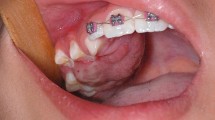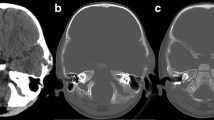Abstract
Malignant fibrous histiocytoma (MFH) is one of the highest-grade sarcomas arising in bone and soft tissue. Its prognosis is poor because of chemoresistance and high metastatic potential to various organs. Few cases arising of MFH of the mandible or oral cavity have been documented. We established a tumor line in nude mice (MFH-N), which was derived from human MFH of the mandible and examined the characteristics of this tumor line. Histologically, MFH-N was identical to the original tumor and showed a storiform-pleomorphic pattern, but had low metastatic potential. Immunohistochemically, both the original and xenografted tumors expressed vimentin, S-100, α-SMA, and histiocytic marker CD68. Lysozyme was expressed by the original tumor, but only sporadically by the xenografted tumor. RT-PCR analysis demonstrated human β-actin in this tumor line, indicating the human origin. In a parallel experiment, we established a new MFH cell line (MFH-NC) from MFH-N. Tumor cells inoculated into the flanks and submandibular region of nude mice developed into tumors histologically similar to MFH-N and the original tumor; multiple lung metastases were detected approximately 5 months after inoculation. The expression levels of various metastasis-related molecules differed between MFH-N and MFH-NC on Western blotting. In MFH-NC, the expressions of MMP7, MMP9, MT1-MMP, CXCR4, COX-2 and integrin α4 were up-regulated, while those of MMP2 and TIMP1 were down-regulated. Expression of TIMP2, integrinαL and sialyl lewis X were not detected in either line. Our findings suggest that the MFH-N tumor line transplantable in nude mice is a useful model for studying the biological behavior of MFH.







Similar content being viewed by others
References
Begg AC, Smith KA (1980) Comparison of natural and artificial lung metastases from a murine tumor of spontaneous origin. In: Hellmann K et al (eds) Metastasis. Martinus Nijhoff, Hague, pp 60–64
Fang Z, Mukai H, Nomura K, Shinomiya K, Matsumoto S, Kawaguchi N et al (2002) Establishment and characterization of a cell line from a malignant fibrous histiocytoma of bone developing in a patient with multiple fibrous dysplasia. J Cancer Res Clin Oncol 128(1):45–49
Hajdu SI, Lemos LB, Kozakewich H, Helson L, Beattie EJ (1981) Growth pattern and differentiation of human soft tissue sarcomas in nude mice. Cancer 47(1):90–98
Hecht F, Berger C, Hecht BK, Speiser BL (1983) Fibrous histiocytoma cell line: chromosome studies of mouse and man. Cancer Genet Cytogenet 8(4):359–362
Iwasaki H, Kikuchi H, Takii M, Enjoji R (1982) Benign and malignant fibrous histiocytomas of the soft tissue. Functional characterization of the cultured cells. Cancer 50(3):520–530
Katenkamp D, kosmehl H, Neupert G (1987) Experimentally induced metastases of malignant fibrous histiocytomas xenotransplanted into nude mice from an established sarcoma cell line (RFS). Exp Pathol 31(2):83–88
Koga H, Naito S, Nakashima M, Hasegawa S, Watanabe T, Kumazawa J (1997) A flow cytometric analysis of the expression of adhesion molecules on human renal cell carcinoma cells with different metastatic potentials. Eur Urol 31(1):86–91
Krause AK, Hinrichs SH, Orndal C, DeBoer J, Neff JR, Bridge JA (1997) Characterization of a human myxoid malignant fibrous histiocytoma cell line, OH931. Cancer Genet Cytogenet 94(2):138–143
Kurihara N, Kubota T, Otani Y, Watanabe M, Kumai K, Kitajima M (1996) Serial growth of human malignant fibrous histiocytoma xenografts in immunodeficient mice. Surg Today 26(4):267–270
Laverdiere C, Hoang BH, Yang R, Sowers R, Oin J, Meyers PA et al (2005) Messenger RNA expression levels of CXCR4 correlate with metastatic behavior and outcome in patients with osteosarcoma. Clin Cancer Res 11(7):2561–2567
Liotta LA, Steeg PS, Stetler-Stevenson WG (1991) Cancer metastasis and angiogenesis: an imbalance of positive and negative regulation. Cell 64(2):327–336
Liu J, Zhan M, Hannay JA, Das P, Bolshakov SV, Kotilingam D et al (2006) Wild-type p53 inhibits nuclear factor-kappaB-induced matrix metalloproteinase-9 promoter activation: implications for soft tissue sarcoma growth and metastasis. Mol Cancer Res 4(11):803–810
Nakatani T, Marui T, Yamamoto T, Kurosaka M, Akisue T, Matsumoto K (2001) Establishment and charactarization of cell line TNMY1 derived from human malignant fibrous histiocytoma. Pathol Int 51(8):595–602
Naruse T, Nishida Y, Hosono K, Ishiguro N (2006) Meloxicam inhibits osteosarcoma growth, invasiveness and metastasis by COX-2-dependent and independent routes. Carcinogenesis 27(3):584–592
Nishio J, Iwasaki H, Ishiguro M, Ohjima Y, Nishimura N, Koga T et al (2003) Establishment of a new human malignant fibrous histiocytoma cell line, FU-MFH-1: cytogenetic characterization by comparative genomic hybridization and fluorescence in situ hybridization. Cancer Genet Cytogenet 144(1):44–51
Oda Y, Yamamoto H, Tamiya S, Matsuda S, Tanaka K, Yokoyama R et al (2006) CXCR4 and VEGF expression in the primary site and the metastatic site of human osteosarcoma: analysis within a group of patients, all of whom developed lung metastasis. Mod Pathol 19(5):738–745
Ohba K, Miyata Y, Koga S, Kanda S, Kanetake H (2005) Expression of nm23-H1 gene product in sarcomatous cancer cells of renal cell carcinoma: correlation with tumor stage and expression of matrix metalloproteinase-2, matrix metalloproteinase-9, sialyl Lewis X, and c-erbB-2. Urology 65(5):1029–1034
Park RH, Yun I (1996) Role of VLA-integrin receptor in invasion and metastasis of human fibrosarcoma cells. Cancer Lett 106(2):227–233
Park HJ, Lee HJ, Min HY, Chung HJ, Suh ME, Park-Choo HY et al (2005) Inhibitory effects of a benz [f] indole-4,9-dione analog on cancer cell metastasis mediated by the down-regulation of matrix metalloproteinase expression in human HT1080 fibrosarcoma cells. Eur J Pharmacol 527(1–3):31–36
Rajapakse N, Kim MM, Mendis E, Huang R, Kim SK (2006) Carboxylated chitooligosaccharides (CCOS) inhibit MMP-9 expression in human fibrosarcoma cells via down-regulation of AP-1. Biochim Biophys Acta 1760(12):1780–1788
Rheinwald JG, Beckett MA (1981) Tumorigenic keratinocyte lines requiring anchorage and fibroblast support cultures from human squamous cell carcinomas. Cancer Res 41(5):1657–1663
Roholl PJ, Rutgers DH, Rademakers LH, De Weger RA, Elbers JR, Van Unnik JA (1988) Characterization of human soft tissue sarcomas in nude mice. Evidence for histogenic properties of malignant fibrous histiocytomas. Am J Pathol 131(3):559–568
Sun R, Hojo H, Kato K, Hashimoto Y (1996) Effects of anti-intercellular adhesion molecule-1 and anti-lymphocyte-function-associated antigen-1 monoclonal antibodies on the metastasis of murine tumors. Invasion Metastasis 16(1):39–48
Weiss SW, Goldblum JR (eds) (2002) Malignant fibrohistiocytic tumors. In: Enzinger and Weiss’s soft tissue tumors, 4th edn. CV Mosby, St. Louis, pp 535–569
Yamamoto H, Fujishiro K, Yamamoto I (1990) Cell line of mouse malignant fibrous histiocytoma with spontaneous metastatic potential. Exp Pathol 39(2):73–78
Acknowledgments
This study was supported by a Grant-in-Aid for Scientific Research from the Ministry of Education, Culture, Sport, Science and Technology of Japan to M.U. (No.18390549), and by the Hyogo College of Medicine Research Funds.
Author information
Authors and Affiliations
Corresponding author
Rights and permissions
About this article
Cite this article
Maeda, T., Hashitani, S., Zushi, Y. et al. Establishment of a nude mouse transplantable model of a human malignant fibrous histiocytoma of the mandible with high metastatic potential to the lung. J Cancer Res Clin Oncol 134, 1005–1011 (2008). https://doi.org/10.1007/s00432-008-0366-6
Received:
Accepted:
Published:
Issue Date:
DOI: https://doi.org/10.1007/s00432-008-0366-6




